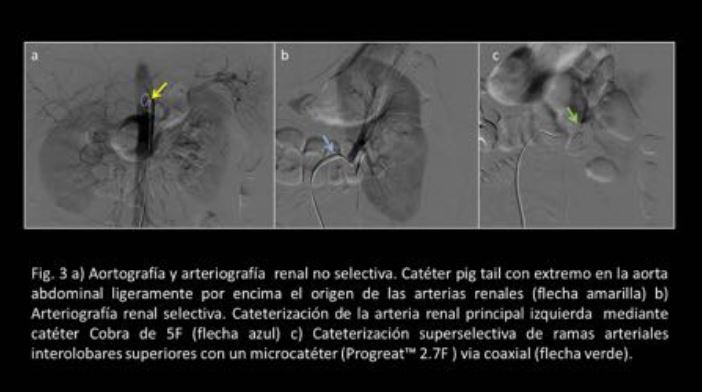TERAPIA DE EMBOLIZACIÓN ARTERIAL RENAL:
REVISIÓN DE PROCEDIMIENTOS ENDOVASCULARES
Palabras clave:
EMBOLIZACIÓN ARTERIAL RENAL, poster, seram, EARResumen
Objetivos Docentes
• Exponer las indicaciones actuales de la terapia de embolización arterial renal • Revisar la técnica, los materiales de embolización y las complicaciones relacionadas con el procedimiento de embolización arterial renal transcatéter a través de la literatura.
• Presentar e ilustrar a través de nuestra experiencia las indicaciones, la elección del material de embolización y los resultados obtenidos en la terapia de embolización arterial renal
Revisión del tema
La embolización arterial renal (EAR) es un procedimiento mínimamente invasivo cuyo objetivo es la oclusión de la arteria renal, principal o de algunas de sus ramas, mediante la inyección endovascular transcatéter de material de embolización. Sirve como alternativa o coadyuva a la cirugía en el manejo de una variedad de transtornos renales con una tasa de complicaciones baja comparativamente a la alternativa quirúrgica.
Descargas
Citas
Turini D, Nicita G, Fiorelli C, Selli C, Villari N. Selective transcatheter arterial embolization of renal carcinoma: an original technique. J Urol 1976; 116: 419– 21
Kadir S, Marshall FF, White RI Jr, Kaufman SL, Barth KH. Therapeutic embolization of the kidney with detachable silicone balloons. J Urol 1983; 129: 11–3
Abada, H. T. & Golzarian, J. Gelatine sponge particles: handling characteristics for endovascular use. Tech. Vasc. Interv. Radiol 2007;10, 257–260.
Sonomura, T. et al. Dependency of tissue necrosis on gelatin sponge particle size after canine hepatic artery embolization. Cardiovasc. Intervent. Radiol 1997;20, 50–53.
Meng, M.V., Brandes, S.B. & McAninch, J.W. Renal trauma: indications and techniques for surgical exploration. World J. Urol. 17, 71–77 (1999).
Titton, R.L., Gervais, D.A., Boland, G.W. & Mueller, P.R. Renal trauma: radiologic evaluation and percutaneous treatment of nonvascular injuries. Am. J. Roentgenol. 178, 1507–1511 (2002).
Morey, A.F. et al. Urotrauma: AUA Guideline. J. Urol. 192, 327–335 (2014).
Kim, J. et al. Transcatheter renal artery embolization with N-butyl cyanoacrylate. ActaRadiol 2012; 53, 415–421.
Cimsit, N. C. et al. Transarterial glue embolization in iatrogenic renovascular injuries. Int. Urol. Nephrol 2008; 40, 875–879.
MacLennan S., et al. Systematic review of oncological outcomes following surgical management of localised renal cancer. Eur. Urol. 2012; 61:972-993.
Kalman D., et al. The role of arterial embolization in renal cell carcinoma. Cand J. Urol. Nephrol. 1999; 33:162-170.
Rouviere, G. et al. Kidney damage due to tuberous sclerosis complex: management recommendations. Diagn Interv Imag. 2013; 94:225-237.
Eskandari, M.K. et al. Aneurysm of the renal artery. Semin Vasc Surg. 2011;18:202-208.
Curs M, et al. Vascular malformations and arteriorvenous fistulas of the kidney. Acts Radiol. 2010;61:144-149.
HaadWeber, M. The impact of residual renal function on survival. Nephrol Diet Transplant. 2009;23:2123-2126.
Delgado, P. Intolerance syndrome in failed renal allografts: incidence and afficacy of percutaneous embolization. Am J Kidn Dis. 2005; 46:339-344.


